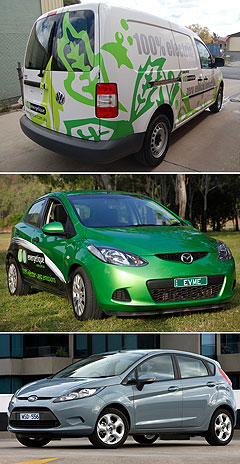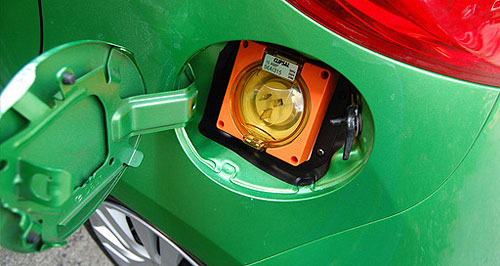Make / Model Search
News - General NewsAussie EV firm set for Chinese dealSocket to 'em: Aussie electric vehicle company Energetique is looking to China for expansion. Energetique set to provide Chinese car-maker with EV tech as Euro exports begin1 Jun 2010 By TERRY MARTIN ONE of Australia’s pioneering electric vehicle companies, Energetique, is on the verge of sealing a deal to supply core EV technologies to a large Chinese car manufacturer for up to 50,000 vehicles a year. Energetique chief executive Phil Coop told GoAuto a memorandum of understanding (MOU) could be signed with the unnamed Chinese manufacturer by the end of this week and that he expected to be flat-out trying to keep up with demand in less than a year. “It’ll be large-scale,” Dr Coop said last week. “I imagine, depending on manufacturing, it will ramp up from smaller numbers – as we’re accustomed to, with technology hold-ups – up to substantial numbers. Numbers between 15-50,000 units a year have been talked about. “We haven’t done the deal yet but we’ll be talking to probably the premium car manufacturer in China. They are looking to put out some very large units – and there are some very large incentives by the Chinese government at the moment to get EVs into fleets, particularly taxi fleets and small buses. “We are going over next week and we’ll be coming away with an MOU – it’s that imminent. We’re pretty confident that we’re ready to strike up a pretty sound agreement. “I expect within 12 months we will be flat-out trying to get components integrated into a Chinese production line.”  From top: Volkswagen MaxEV, Mazda2 evMe, Ford Fiesta. From top: Volkswagen MaxEV, Mazda2 evMe, Ford Fiesta.So up to 50,000 units within what sort of timeframe? “A year.” Dr Coop said difficulties encountered by the Armidale, NSW, technology company in obtaining government support had forced it to look for alliance partners overseas and to abandon its emphasis on providing EVs to private customers in Australia and abroad. With its EV driveline technology entering a second generation, Energetique is working to become a key technology supplier to overseas manufacturers, which can develop their own range of cost-effective EVs based on their existing models and production lines. “What we’ll be planning on doing is negotiating to have our technology implemented into their production lines,” Dr Coop said. “We are integrators, and the integration is all about software. So what we’re providing is integration expertise, and the funding that is coming out of China at the moment is all about building up domestic capacity. “What we’re doing is we’ll provide an initial ‘demonstration line’ if you like, and they might do small runs of those, or large runs of those – that’s not really decided yet – but what they would want us to do is to start with the integration that takes them back to their domestic product. “I don’t fully understand the Chinese culture, but it seems to me that they have a huge domestic demand, so they will be focusing on that. But running alongside that is this underlying cult that they feel that they’ve actually achieved something substantial if they can get access to the European market. “So I’ll be interested to see how that plays out.” Energetique is continuing to convert small numbers of vehicles to EVs at its Armidale headquarters – cars now based on the Ford Fiesta compact hatch rather than the Mazda2, as well as Volkswagen’s Caddy light van – but these are being targeted at large fleets, including freight companies and particularly energy utilities who want to test the integration of EVs with the electricity grid. Energetique has entered joint-venture projects with power companies in Australia, and is also expanding its presence in Europe and the UK with German automotive engineering service provider RLE International. On the product side, it is also looking at extending its EV technology to Ford’s Focus small car. “We play a strategy that has two prongs to it – one is Europe and one is China,” said Dr Coop, adding that the Chinese market will likely look for high volume over a shorter timescale while Europe and the UK will demand more “premium technology” which will take a longer time to assess before shifting gear into larger-scale contracts. Dr Coop said the company recently shipped a Caddy Maxi EV, which it dubs the MaxEV, to Europe for use in electric-car trials in Europe. The MaxEV is the company’s first foray overseas, and Dr Coop said the vehicle would be commissioned soon, with strong demand for vehicles such as this among a range of fleets, including a large freight delivery firm which he said was unable to source enough electric-powered vans. Energetique is also working to place some vehicles in the UK, which is running large-scale EV trials in London and elsewhere. Once European trials are completed and fleet orders increase, the Australian company will seek to build vehicles through a European contract manufacturer, such as Valmet Automotive in Finland. “We now have vehicles in Europe that are going into trial,” Dr Coop said. “We’re getting huge interest – far more interest than our company can service, really, from two sources. One is from vehicles required for trial the other is from energy companies wanting vehicles to play on their grid. “We’re only entertaining fleets at this stage. Our concern is that the world is looking to better understand this technology, rather than to simply sell vehicles. There are so many problems – there are no service centres (for example) – and, you know, this whole notion of ‘retail electric cars’ I think has a long way to go yet.” Dr Coop said Australia had seen a taste of some of that technology with the Mitsubishi i-MiEV and the Nissan Leaf, which are leading the charge among the global manufacturers and could be on sale here, in limited numbers, within two years. However, he emphasised that the technology was moving at an incredibly fast rate and that it was important for EVs to be compatible with emerging requirements, such as full vehicle-to-grid (V2G) integration and compatibility with rapid-charge points. “The world market is moving so rapidly in this technology, driven by energy utilities, with so much activity by OEMs – vehicle manufacturers – and in particular there is a new subset forming around the OEMs,” he said. “The OEMs are having a problem because they can’t move quick enough, so there is this new smaller group of more agile developers that are hooking in to smaller-scale production around the world.” Energetique’s goal in the Australian market is to ramp up orders from a handful to many more than that, though less than 50, over the next 12 months. “Going into trials is our expertise,” Dr Coop said. “If we were to just look at putting out a quick (less sophisticated) vehicle, they would need to be around $30,000 to $40,000 and we can’t do that at the moment, not with the technology that’s going into them,” he said. “We are happy to sell at $70,000 but the car costs us about $120,000 to build. That’s just the technology that’s in the car. “The vehicles that we provide, and the demand for our vehicles which is starting to be recognised, are ideal for trials. The Nissan, the Mitsubishi are vehicles that you can buy and you can charge and you can drive – that’s it.” “It’s funny that they should do that at a time when the energy companies are petrified that the world’s fleet of vehicles is coming on to their grid. And yet, they can’t ‘open them up.’” According to Dr Coop, the privately funded Energetique has received no government assistance but invested around $3 million in its first-generation EV system. He said it spent a further $2 million with the move to new platforms and developing the technology for its front-drive-based second-generation EV driveline. He also said the latest generation was a “full rebuild” that is not restricted to a particular vehicle body style. It carries over the same Swiss-sourced 89kW/220Nm ‘hybrid synchronous’ liquid-cooled electric motor and South Korean-sourced lithium polymer battery pack, and offers a similar ‘workable’ driving range of about 200km as the previous Mazda2-based evMe – now being described as a prototype and which Energetique managed to sell to only one or two customers. Built off the same basic vehicle architecture as the Mazda2, the Fiesta version still offers sub-10-second 0-100km/h acceleration. The new generation does, however, forego a conventional gear lever in the donor vehicle, using a touch-screen instead for all relevant inputs into the car’s operation. Dr Coop said this was necessary with increasingly digital functionality, including compatibility with V2G and rapid-charge regimes. “We are now at a platform where we’re able to look at volume sales and fleet (contracts),” he said. “Gen I was really prototyping, it was finetuning, it was looking at weight and balances of energy, developing vehicle-to-grid, developing ‘smart grid’ – that all came along as well. “We also realised that not many companies are going to make a dedicated EV body. Automotive companies, around the planet, have had a pretty tough time (with the economic downturn) and they’re certainly not going to throw another few hundred million bucks into a new body just to run out EV, when they’re really unsure what that market is yet. “For a while it’s going to be putting technology into existing body styles on their production lines. So what we did is make a very modular battery drivetrain we call the cradle or the power module that will fit into almost any front-wheel drive. “And the battery box was completely redesigned so that a full battery pack can go into the rear of a (compact car) without touching any bodywork.” Dr Coop also cautioned that there is much more to be learnt from electric vehicles, and that the technology will continue to evolve, which in turn could create difficulties for manufacturers of the first wave of mass-marked EVs. “We’re still moving very cautiously (with our own vehicles). The technology is not mature,” he said. “I see the troubles that we’re having with electronics, with power electronics, with vehicle systems – and we’re working with the world’s best (component) manufacturers here. But we still have problems. “When you see the Nissan Leaf come out, and these guys are thinking they are going to make these on a large scale ...” He also said the effects of the global financial crisis were delaying the introduction of EVs, with one of Energetique’s component suppliers still needing time to ramp up production “at a time when the electric vehicle manufacturers are crying out for electronics”. A little over 12 months ago, Energetique launched the evMe and, according to Dr Coop, had received more than 100 expressions of interest from Australian companies and consumers. Now its focus is with manufacturers, fleet customers and large trial programs offshore. “There’s nothing much happening in Australia,” he said. “We always feel that we are a long way from where the technology is happening. We are always talking at odd hours to Europe, to China, to the UK, just trying to stay in touch, be represented, and be right on the forefront. “I can’t think of anyone in Australia that I can have that conversation with, that understands the market, what’s actually happening, where decisions are being made, and the (government) policy down here ... we need policy leadership that is going to make a commitment to renewable mobility (but) that isn’t happening. “There’s really nothing much here in Australia that provides that sort of incentive or that sort of security.”  Read more |
Click to shareGeneral News articlesResearch General News Motor industry news |











Facebook Twitter Instagram